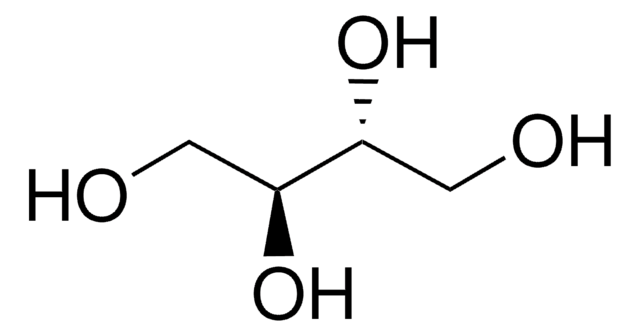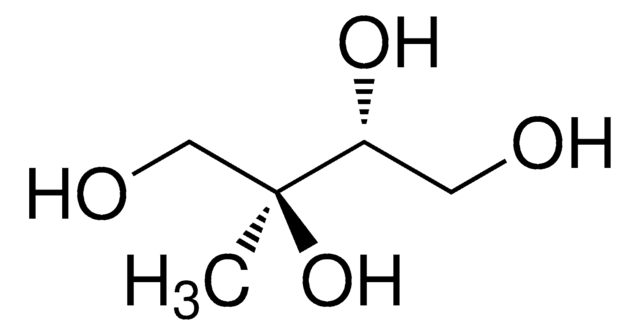おすすめの製品
グレード
pharmaceutical primary standard
APIファミリー
erythritol
メーカー/製品名
EDQM
bp
329-331 °C (lit.)
mp
118-120 °C (lit.)
アプリケーション
cleaning products
cosmetics
food and beverages
personal care
pharmaceutical (small molecule)
フォーマット
neat
保管温度
2-8°C
SMILES記法
OC[C@@H](O)[C@@H](O)CO
InChI
1S/C4H10O4/c5-1-3(7)4(8)2-6/h3-8H,1-2H2/t3-,4+
InChI Key
UNXHWFMMPAWVPI-ZXZARUISSA-N
類似した製品をお探しですか? 訪問 製品比較ガイド
詳細
この製品は薬局方標準品です。発行元の薬局方により製造・供給されています。MSDSを含む製品情報などの詳しい情報は、発行元の薬局方のウェブサイトよりご確認ください。
アプリケーション
Erythritol EP Reference standard, intended for use in laboratory tests only as specifically prescribed in the European Pharmacopoeia.
生物化学的/生理学的作用
Tas1r3遺伝子の対立遺伝子変異は、この糖アルコールに対する行動的味覚応答に影響することから、T1R3レセプターリガンドであることを示唆しています。
包装
The product is delivered as supplied by the issuing Pharmacopoeia. For the current unit quantity, please visit the EDQM reference substance catalogue.
その他情報
Sales restrictions may apply.
保管分類コード
11 - Combustible Solids
WGK
WGK 1
引火点(°F)
Not applicable
引火点(℃)
Not applicable
適用法令
試験研究用途を考慮した関連法令を主に挙げております。化学物質以外については、一部の情報のみ提供しています。 製品を安全かつ合法的に使用することは、使用者の義務です。最新情報により修正される場合があります。WEBの反映には時間を要することがあるため、適宜SDSをご参照ください。
Jan Code
Y0000177-1EA:
Y0000177:
最新バージョンのいずれかを選択してください:
この製品を見ている人はこちらもチェック
Yong-Cheol Park et al.
Journal of chromatography. B, Analytical technologies in the biomedical and life sciences, 815(1-2), 251-260 (2005-01-18)
In-depth knowledge bases on physiological properties of microbes are required to design a better microbial system at a gene level and to develop an industrially viable process in an optimized scheme. Proteomic analyses of industrially useful microorganisms are particularly important
M Wanke et al.
Acta biochimica Polonica, 48(3), 663-672 (2002-02-09)
Higher plants, several algae, bacteria, some strains of Streptomyces and possibly malaria parasite Plasmodium falciparum contain the novel, plastidic DOXP/MEP pathway for isoprenoid biosynthesis. This pathway, alternative with respect to the classical mevalonate pathway, starts with condensation of pyruvate and
Deepak Ganjewala et al.
Current issues in molecular biology, 11 Suppl 1, i35-i45 (2009-02-06)
Isoprenoids, also known as terpenoids, are biosynthesized by the condensation of the two C5 unit isopentenyl diphosphate (IPP) and isomer dimethylallyl diphosphate (DMAPP). Generally, plants use two separate pathways plastidial Methyl-erythritol-4-phosphate (MEP) and cytosolic acetate-mevalonate (MVA) pathways for formation of
Erythritol: a novel noncaloric sweetener ingredient.
P de Cock
World review of nutrition and dietetics, 85, 110-116 (2000-01-27)
A Banerjee et al.
Natural product reports, 31(8), 1043-1055 (2014-06-13)
Covering: up to February 2014. The methylerythritol 4-phosphate (MEP) pathway is the recently discovered source of isoprenoid precursors isopentenyl diphosphate (IDP) and dimethylallyl diphosphate (DMADP) in most bacteria, some eukaryotic parasites, and the plastids of plant cells. The precursors lead
ライフサイエンス、有機合成、材料科学、クロマトグラフィー、分析など、あらゆる分野の研究に経験のあるメンバーがおります。.
製品に関するお問い合わせはこちら(テクニカルサービス)









